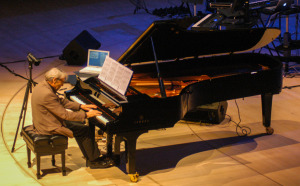The Triple CCRMAlite performance this past Sunday at Bing Concert Hall was a celebration of three important dates for the Center for Computer Research in Music and Acoustics (CCRMA): the 40th anniversary of CCRMA, the 50th anniversary of the first computer program for music on campus, and the 80th birthday of CCRMA founder John Chowning Ph.D. ’66. The program featured a science fair of student research in the lobby, as well as a concert showcasing works from Chowning, French composer Jean-Claude Risset, and former CCRMA Research Associate Bill Schottstaedt.

CCRMA, as an academic research center, presented the pieces not just as art, but as showcases of intellectual inquiry — and in retrospect, Triple CCRMAlite was framed like a giant PowerPoint presentation, foregoing program notes at Triple CCRMAlite in favor of slides that formed a backdrop on the stage. Each piece was introduced, not with a speaker, but with long paragraphs of personal, musical and cultural context displayed on the screen. For some of the pieces, the information on the screen would continue as a backdrop for the performance. For instance, there was a video projection of Risset’s keyboard during “Duet for one pianist: Three Études” and a contextual slide for Chowning’s “Voices,” so that the focal point of the pieces was both the artistic and intellectual value.
Yet the academic focus of the concert was illuminating, rather than alienating. It pushed the audience to see that these pieces were not just for the ears and the soul, but for the minds — that each piece was not just a work of art but a showcase of a technological advancement in music.
Risset’s “Duet for one pianist: Three Études,” containing “Echo,” “Narcisse” and “Mercure,” would not be possible without the Yamaha Disklavier, with a MIDI input and output, as well as computer software, specifically Max. As Risset performed his etudes, Max would perform the accompaniment by reading in the notes Risset played, which triggered responses back to the piano so that the keys would depress and release on their own. The result was a phantom accompanist — marvelously chilling.
Similarly, Chowning’s “Voices” was not just a demonstration of artistic prowess but of technological advancement. The piece featured soprano Maureen Chowning, as well as the synthesized sounds generated by Chowning and MaxMSP; this software read in the pitches of Chowning’s voice as it spilled into the hall, which it used to trigger musical sparks and clanging.
While Triple CCRMAlite was technically a concert, it is more accurate to call it a palette of sounds, ranging from the pitter-patter of Chowning’s “Turenas” to the sonic sprays of CCRMA alumna Leah Reid’s “Ring, Resonate, Resound.” These pieces turned Bing into a sound lab, a giant kettle of sound deflecting from the floor, the walls and the ceiling. Each piece transformed Bing into a different space. Chirps and twinkles from Schottstaedt’s “I’m Late” seemed to bubble in a basin. Harsh buzzing and the sounding of horns seemed to swirl in a conch shell for Perry Cook’s “Lanzon: Echoes.” And musical breezes seemed to waft and flutter in an open meadow for Kotoka Suzuki’s “Shimmer, Tree” with Chryssie Nanou.
After the concert, I paused outside of Bing for a moment. The hum of conversation, the metallic creaking of bicycles and the whispering of leaves crescendoed into a symphony I’d never heard before. Triple CCRMAlite reopened our ears to music. It was a reminder that music could be as simple as the static popping of applause, that all we had to do was listen a little harder to the wind swirling in our ears and to the clinking of bottles at the dining table, to be reminded that elements of music are all around us — that music is what we make of it.
The Triple CCRMAlite program and exhibits can be found here. For a live stream of the event, click here.
Correction: Nov. 4, 2014
An earlier version of this story misidentified Leah Reid; Leah Reid is an alumna of CCRMA, not a student. She also performed “Ring, Resonate, Resound,” not “Ring, Resound, Resonate” as previously misidentified.
Contact Irene Hsu at ihsu5595 ‘at’ stanford.edu.
